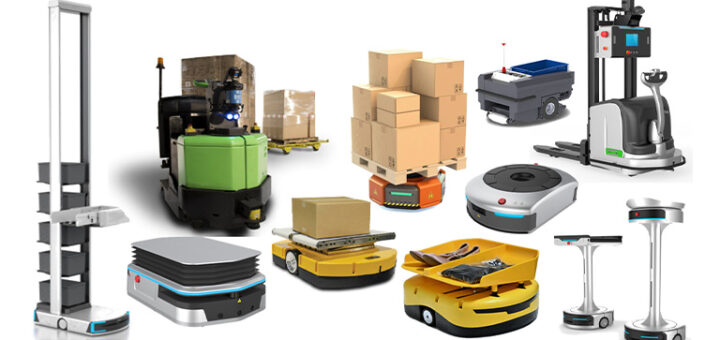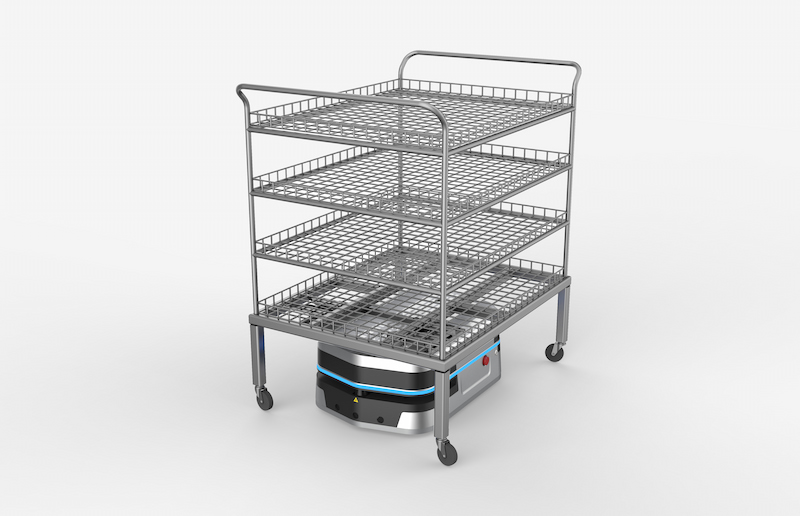How to Use AMRs for Material Transportation in Your Operation

Years ago, the only way to transport materials, parts, or inventory within a facility was manually. Personnel was hired specifically to transport material from point A to point B using either carts or forklifts. At the time, this was a necessary expense, because there simply weren’t many feasible alternatives.
Of course there have been conveyor systems. Conveyors can be incredibly efficient in transporting inventory. The issue with conveyors is lack of flexibility, as they cut off the flow of a facility. Additionally, conveyors can be costly in terms of both initial purchase price as well as maintenance. In the right application it’s perfect, but for many other applications and situations not desirable.
The next real advancement in terms of intra-warehouse or intra-operation transportation came with the development of automated guided vehicles (AGVs)—unmanned vehicles capable of traveling within a facility using a series of cameras, sensors, and magnetic strips or rails. AGVs promised to reduce labor costs by automating the repetitive and low-skill task of transportation.
Download Our Guide to Autonomous Mobile Robots (AMRs)
At the time, it was a major step in the right direction, but it’s important to note that AGVs brought their own challenges. The main problem was similar to conveyors: A lack of flexibility. First-generation AGVs relied upon fixed paths that were very rigid and difficult to reprogram. This made them impractical for flexible operations that found themselves rapidly growing or changing to meet shifting customer demands.
Recent advancements in technology have created a new solution for material transportation in your warehouse or operation: Autonomous Mobile Robots (AMRs), which can in many ways be thought of as the next evolution of the AGV.
What is an autonomous mobile robot (AMR)?
An autonomous mobile robot (AMR) is just that: A robot capable of moving throughout its environment autonomously and without the direct oversight or control of an operator. This is achieved through the use of a variety of sophisticated sensors that allow the AMR to take in information about the environment and chart its own efficient path from point A to point B.
AMRs come in a wide variety of types, manufacturers, and models each of which is better suited to a particular task or role within an order fulfillment operation. While some AMRs are better suited for picking or sorting, for example, others are perfectly suited to perform the tasks that previously would have been relegated to AGVs, such as material or inventory transport.
Using AMRs to Transport Materials & Product Within Your Facility
A variety of AMRs have been designed specifically to fulfill the task of material/inventory transportation. These include tugger-bots capable of moving multiple pallets or gaylords full of product or inventory, as well as models designed to transport pallets, flowrack, cases, totes, and single units.
The primary difference between how AMRs and AGVs work comes down to flexibility: AMRs are vastly more flexible than their AGV counterparts. Whereas AGVs travel along pre-established routes marked by magnetic wires or tape, AMRs use their suite of sensors and on-board map to understand their location within a facility and craft their own routes safely and effectively. If an AGV runs into an obstacle such as a pallet, forklift, person along its path, it must wait for that obstacle to be removed. An AMR, on the other hand, is capable of identifying an obstacle and then rerouting itself—saving time and increasing efficiency.
Need expert advice? Book a free consultation with one of our systems integrators today!

Below are a number of examples of ways you might leverage AMRs to transport product or inventory within your facility:
- Inbound receiving and putaway
- Moving inventory to a forward pick face
- Moving inventory to buffer
- Moving inventory to a pickstation for Goods-to-Person picking
- Moving picked orders to packing and shipping
- Replenishment
- Etc.
Benefits of Using AMRs for Transport
The single greatest benefit of using AMRs for transportation within your facility is simple: Transporting inventory or materials is a low-skill and repetitive task. Automating the task with AMRs allows you to reallocate your personnel to other, higher-value tasks and reduce your overall labor costs.
Additionally, by leveraging AMRs instead of manually driven forklifts, you’ll cut down on traffic throughout your facility, especially in aisles. This typically leads to increased safety, fewer accidents, reduced shrinkage, and higher throughputs.
While you may still need to rely upon manual forklifts for some activities, your reliance will be vastly reduced. A secondary benefit of this will be that you’ll save money on your forklift fleet due to reduced leasing and maintenance costs.
AMRs vs. Conveyors or Sorters
For many order fulfillment operations looking to automate their intra-facility transportation, autonomous mobile robots will often prove a flexible, cost effective option. But this doesn’t mean that they will be the best option for every business.
For example, operations with exceptionally high throughput requirements may be better served by implementing a conveyor or sorter such as a tilt-tray or crossbelt sorter, which typically offer higher throughputs compared to AMRs. Of course, this increased throughput comes at its own costs: Typically in the form of an investment of floor space. In the debate over AMRs vs. conveyors, the tradeoff will almost always boil down to throughput vs. flexibility.
Then again, the answer doesn’t always need to be an either/or. For the right business, it may be possible to leverage both AMR-technology and more traditional conveyors or sorters. An example might be to use conveyors to replenish your fastest movers, while leveraging AMRs to replenish slower movers.
AMR Transportation Applications, Options, and Choices
If you are interested in using AMRs for material transport within your operation, there are a wide variety of options based on your exact requirements.

Transporting totes or cartons from one portion of your warehouse to another with the ability to lift them off the ground and place them on the rack.

Moving pallets from one part of the facility to another.

Storing and retrieving pallets from rack and delivering them to shipping, Q&A, work cells and other locations in the facility.

Transporting carts, bins, shelving or fixtures from station to station can eliminate a tremendous amount of labor while increasing throughput.

Moving cases from one zone to another.

Tugging carts or vehicles to specific areas or cells throughout the facility.
Understanding Your Options
If you are looking to automate repetitive, low-value tasks within your operation to increase efficiency and decrease costs, the good news is that there are a number of different automation technologies that can help you meet your goals. One option is autonomous mobile robots (AMRs), but others include sorters, conveyors, and more. A trusted systems integrator can help you understand the differences between each of these technologies so that you are choosing the best one for your business.





